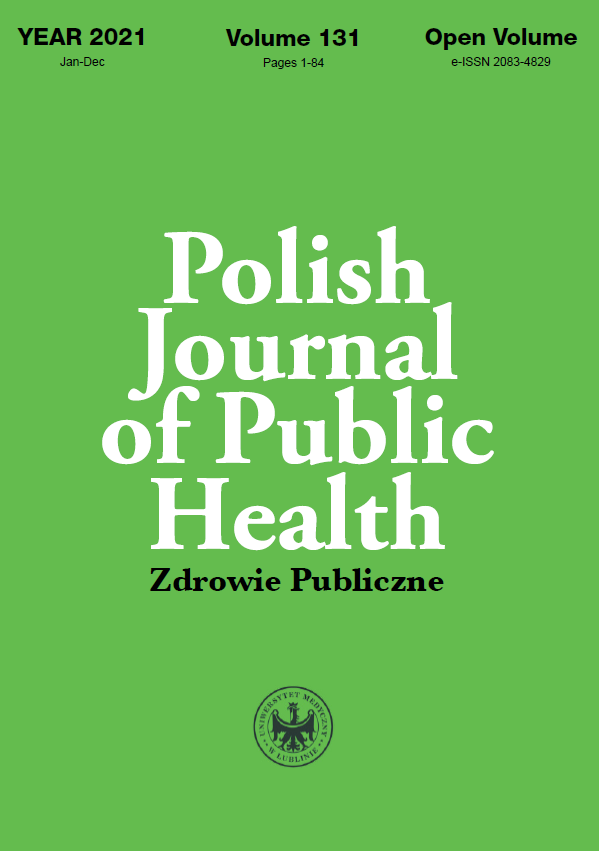PTSD symptoms and coping mechanism of nurses in Poland before the COVID-19 pandemic. A cross-sectional study
DOI:
https://doi.org/10.2478/pjph-2021-0015Keywords:
posttraumatic stress disorder (PTSD), secondary traumatic stress (STS), nurse, coping, COVID-19, pandemicAbstract
Introduction. Secondary traumatic stress (STS) is a consequence of the indirect experience of trauma. The symptoms of STS are similar to those experienced by people who directly experience traumatic events in the form of posttraumatic stress disorder (PTSD).
Aim. The aim of the study was to determine the frequency of the symptoms of PTSD and to establish the role of coping strate- gies in the development of PTSD symptoms among Polish nurses. The study was conducted before the COVID-19 pandemic.
Material and methods. The study was conducted in the Podkarpackie Province (Poland) in clinical hospitals and hospital out- patient clinics. The results of studies conducted among 509 nurses were analyzed. The mean age of the respondents was 35 years, and the mean work seniority was 11 years. The IES-R scale and Mini-COPE were used in the study.
Results. At least moderate PTSD symptoms were found in 42.4% of the surveyed nurses. The results showed that maladaptive stress coping strategies played a major role in the development of PTSD symptoms in the group of nurses.
Conclusion. Nurses are a professional group exposed to a high risk of traumatic encounters that may result in PTSD/STS, therefore this professional group should be targeted at prophylactic programs and training in dealing with traumatic stress. The COVID pandemic and the related restrictions, organizational chaos, constant fear and a sense of danger are serious traumatizing factors and can seriously contribute to the increase in stress disorders among nurses and other medical professionals.
References
1. Bouchard, L. Compassion fatigue in advanced practice registered nurses: Why don’t we know more? Nurs Clin North Am. 2019;54(4):625-37.
2. Peters E. Compassion fatigue in nursing: A concept analysis. Nurs Forum. 2018;53(4):466-80.
3. Si M-Y, Su X-Y, Jiang Y, et al. Psychological impact of COVID-19 on medical care workers in China. Infect Dis Poverty. 2020;9:113.
4. Rodríguez BO, Sánchez TL. The psychosocial impact of COVID-19 on health care workers Int Braz J Urol. 2020;46(Suppl.1):195-200.
5. Naczelna Izba Pielęgniarek i Położnych; 2020. [https://nipip.pl/liczba- pielegniarek-poloznych-zarejestrowanych-zatrudnionych/]
6. Juczyński Z, Ogińska-Bulik N. Pomiar zaburzeń po stresie traumatycznym – polska wersja Zrewidowanej Skali Wpływu Zdarzeń. Psychiatria. 2009;6(1):15-25.
7. Carver CS, Scheier MF. Situational coping and coping dispositions in a stressful transaction. J Pers Soc Psychol. 1994;6(1):184-95.
8. Spoorthy MS, Pratapa SK, Mahant S. Mental health problems faced by healthcare workers due to the COVID-19 pandemic – A review. Asian J Psychiatr. 2020;51:102119.
9. Song X, Fu W, Liu X, et al. Mental health status of medical staff in emergency departments during the Coronavirus disease 2019 epidemic in China. Brain Behav Immun, 2020;88:60-5.
10. Tan BYQ, Chew NWS, Lee GKH, et al. Psychological Impact of the COVID-19 Pandemic on Health Care Workers in Singapore. Ann Intern Med. 2020;18;173(4):317-20.
11. Chew NWS, Lee GKH, Tan BYQ, et al. A multinational, multicentre study on the psychological outcomes and associated physical symptoms amongst healthcare workers during COVID-19 outbreak. Brain Behav Immun. 2020;88:559-65.
12. Forte G, Favieri F, Tambelli R, Casagrande M. COVID-19 Pandemic in the Italian Population: Validation of a Post-Traumatic Stress Disorder Questionnaire and Prevalence of PTSD Symptomatology. Int J Environ Res Public Health. 2020;17(11):4151.
13. Shechter A, Diaz F, Moise N. Psychological distress, coping behaviors, and preferences for support among New York healthcare workers during the COVID-19 pandemic. Gen Hosp Psychiatry. 2020;66:1-8.
14. Schuster M, Dwyer PA. Post‐traumatic stress disorder in nurses: An integrative review. J Clin Nurs. 2020;29:2769-87.
15. Beck ChT, Cusson RM, Gable RK. Secondary Traumatic Stress in NICU Nurses: A mixed-methods study. Adv Neonatal Care. 2017;17(6):478-88.
16. Tirgari B, Forouzi MA, Ebrahimpour M. Relationship between posttraumatic stress disorder and compassion satisfaction, compassion fatigue, and burnout in Iranian psychiatric nurses. J Psychosoc Nurs Ment Health Serv. 2019;57(3):39-47.
17. Jacobowitz W. PTSD in psychiatric nurses and other mental health providers: a review of the literature. Issues Ment Health Nurs. 2013;34(11):787-95.
18. Beck ChT, Gable RA. A mixed methods study of secondary traumatic stress in labor and delivery nurses J Obstet Gynecol Neonatal Nurs. 2012;41(6):747-60.
19. Kellogg MB, Knight M, Dowling JS, Crawford SL. Secondary traumatic stress in pediatric nurses. J Pediatr Nurs. 2018;43:97-103.
20. Salmon G, Morehead A. Posttraumatic Stress Syndrome and implications for practice in critical care nurses. Crit Care Nurs Clin North Am. 2019;31(4):517-26.
21. Rodríguez-Rey R , Palacios A, Alonso-Tapia J, et al. Burnout and posttraumatic stress in pediatric critical care personnel: Prediction from resilience and coping styles. Aust Crit Care. 2019;32(1):46-53.
22. Mealer M, Jones J, Meek P. Factors affecting resilience and development of posttraumatic stress disorder in critical care nurses. Am J Crit Care. 2017;26(3):184-92.
23. Ratrout HF, Hamdan-Mansour AM. Secondary traumatic stress among emergency nurses: Prevalence, predictors, and consequences. Int J Nurs Pract. 2020;26(1):e12767.
24. Duffy E, Avalos G, Dowling M. Secondary traumatic stress among emergency nurses: a cross-sectional study. Int Emerg Nurs. 2015;23(2):53-8.
25. Morrison LM, Joy JP. Secondary traumatic stress in the emergency department. J Adv Nurs. 2016;72(11):2894-906.
26. Sterud T, Ekeberg Ø, Hem E. Health status in the ambulance services: a systematic review. BMC Health Serv Res. 2006;6:82-110.
27. Kosydar-Bochenek J, Lewandowski B, Ozga D. The role of coping strategies in posttraumatic stress disorder symptoms in paramedics: a crosssectional study from Poland. Prz Lek. 2019;4:157-62.
28. Kosydar-Bochenek J, Ozga D, Mędrzycka-Dąbrowska W, Lewandowski B. Can resuscitation bring positive changes for paramedics? Polish experiences. Resuscitation. 2017;117:17.
29. Kucmin T, Kucmin A, Turska D, et al. Coping styles and dispositional optimism as predictors of post-traumatic stress disorder (PTSD) symptoms intensity in paramedics. Psychiatr Pol. 2018;30;52(3):557-71.
Downloads
Published
Issue
Section
License
Copyright (c) 2021 Authors

This work is licensed under a Creative Commons Attribution-NonCommercial-NoDerivatives 3.0 Unported License.


